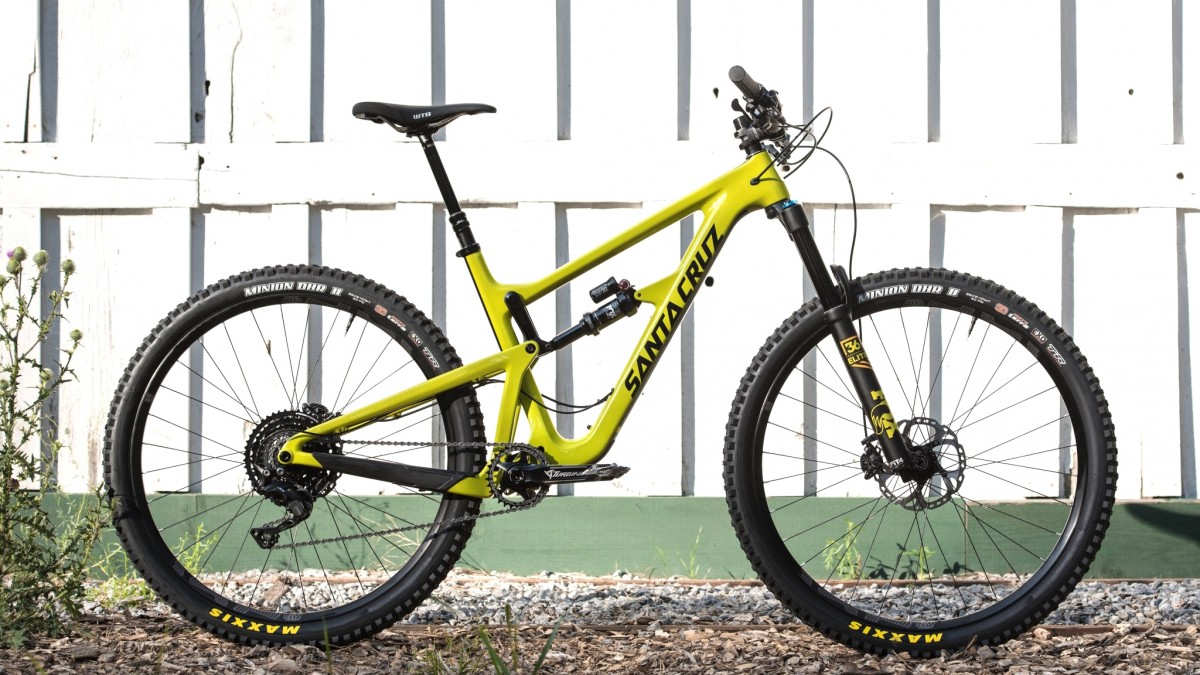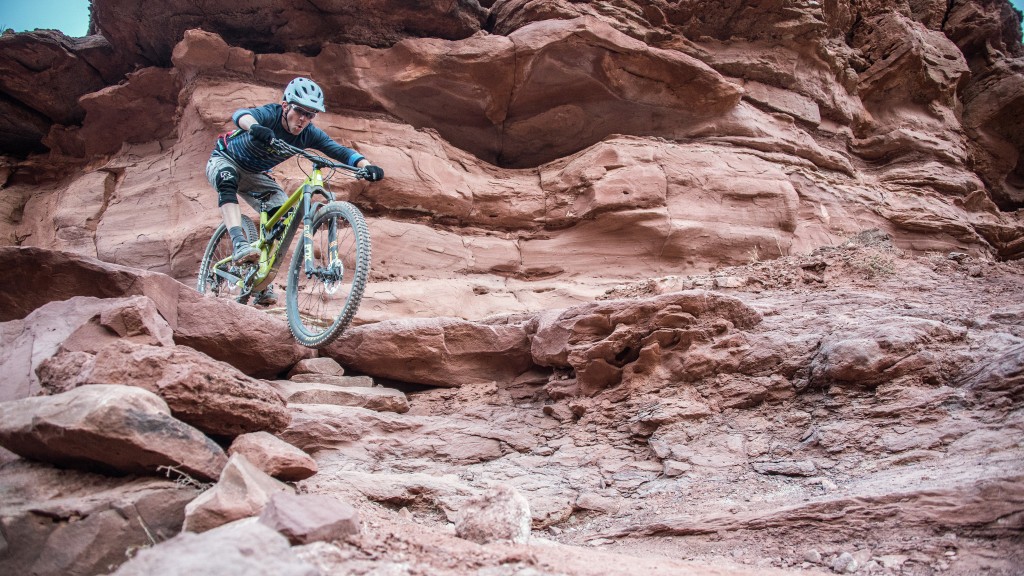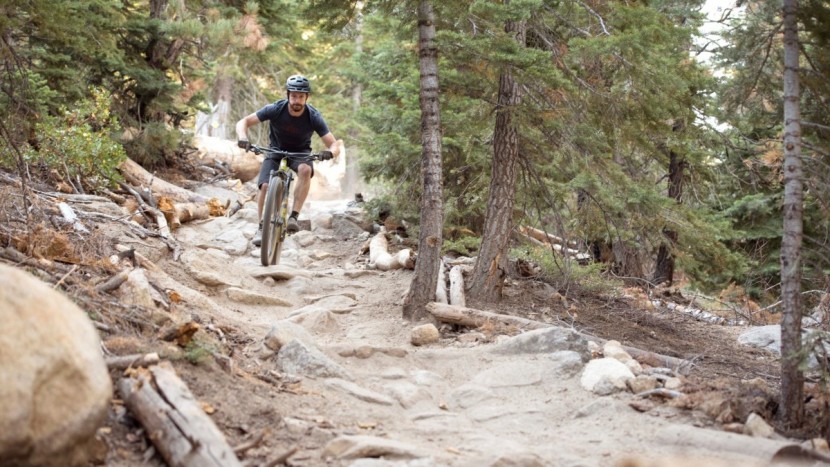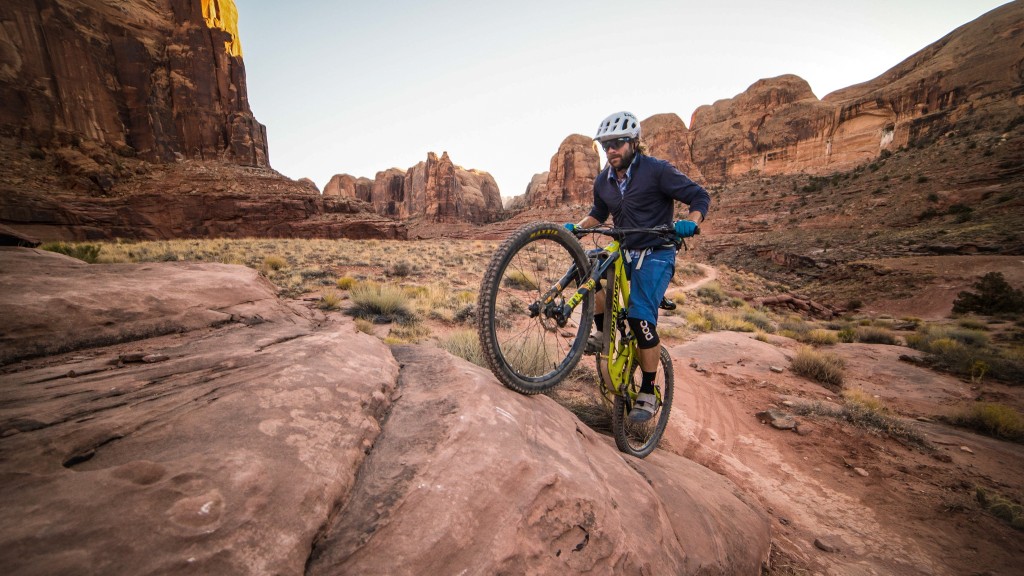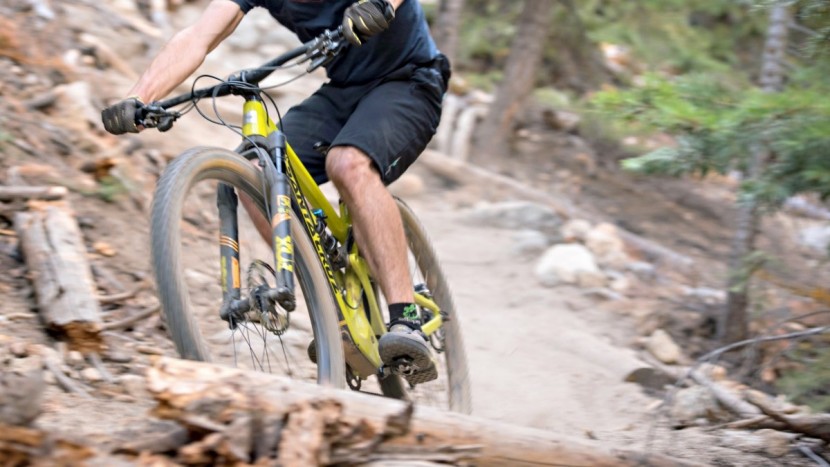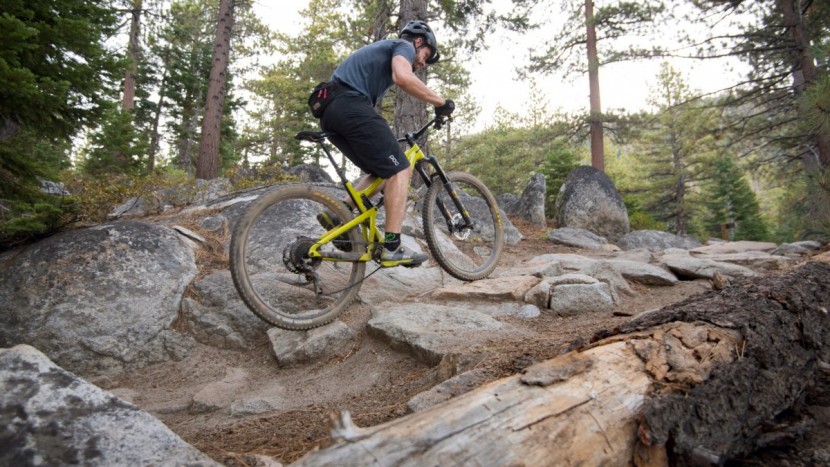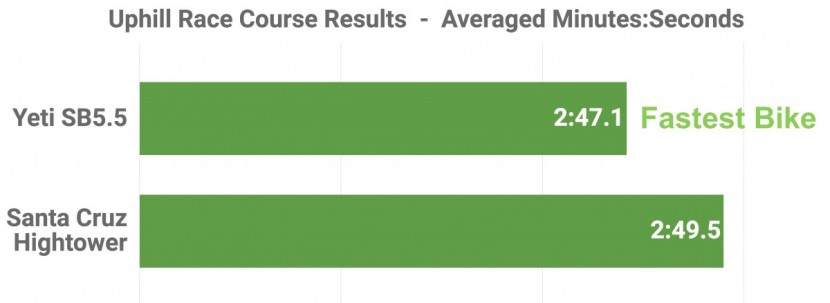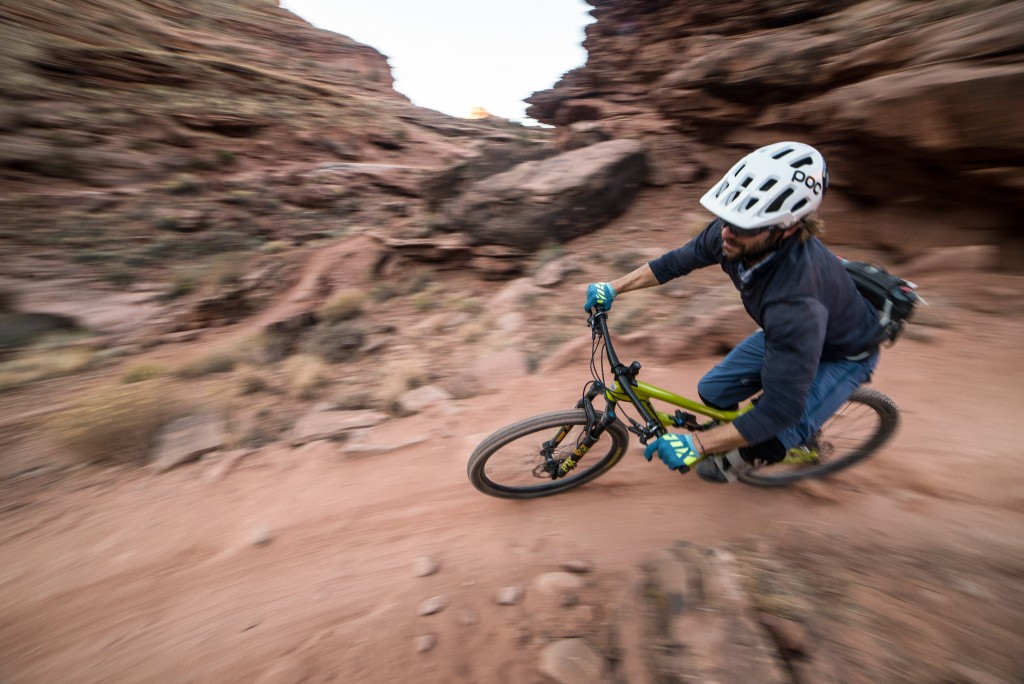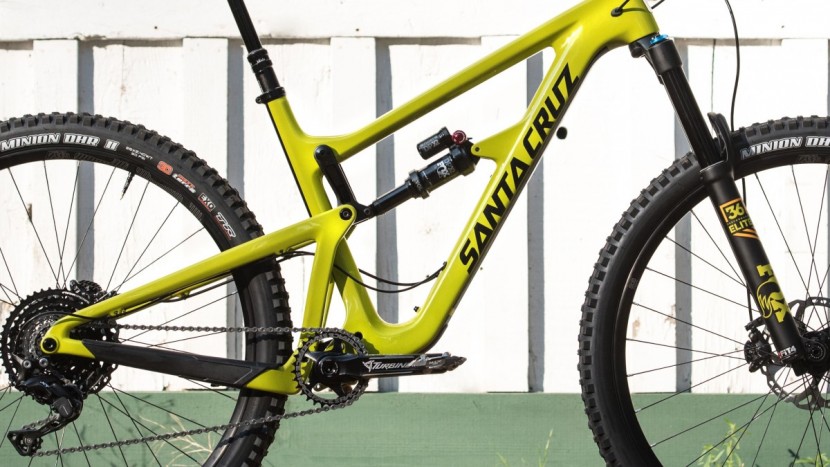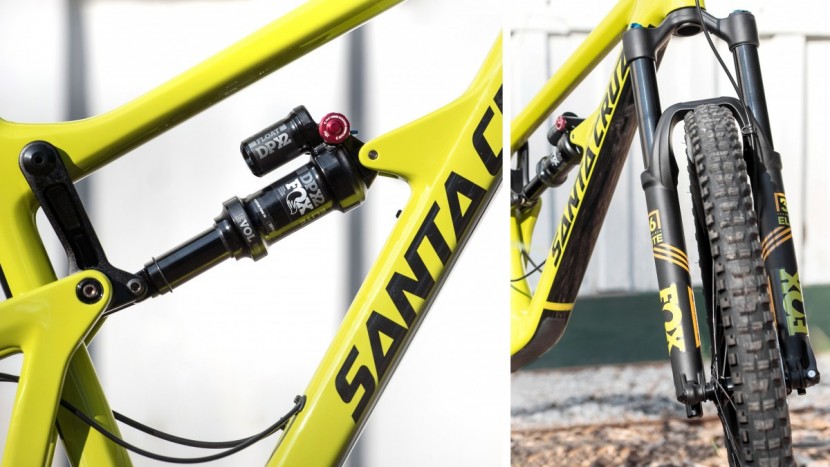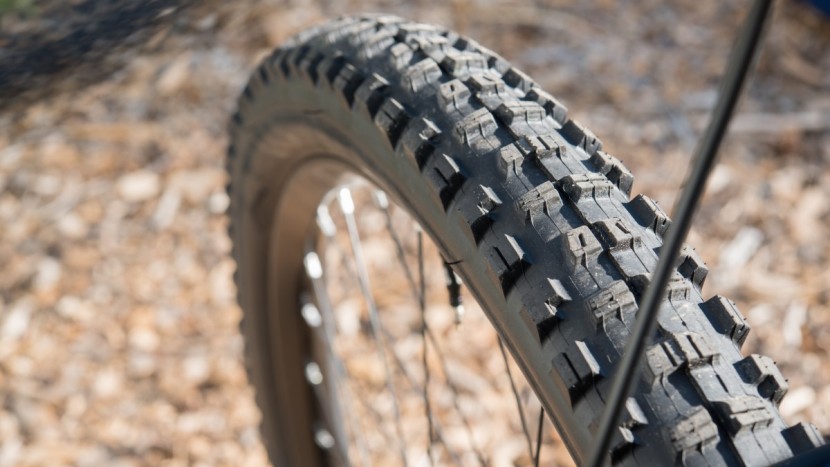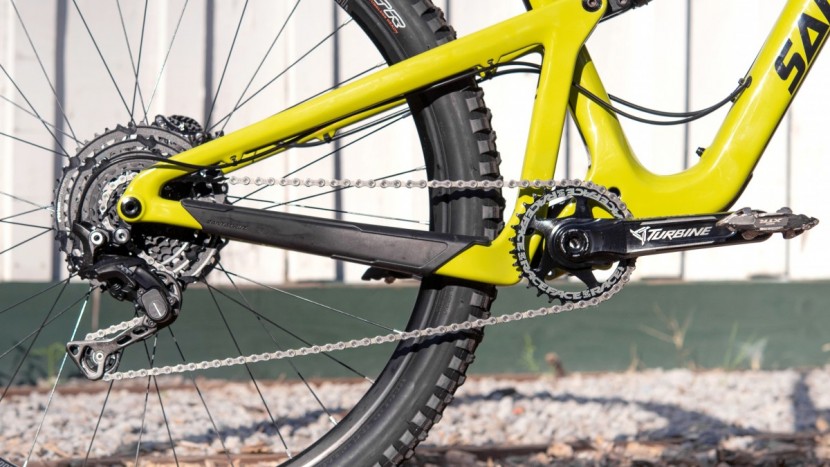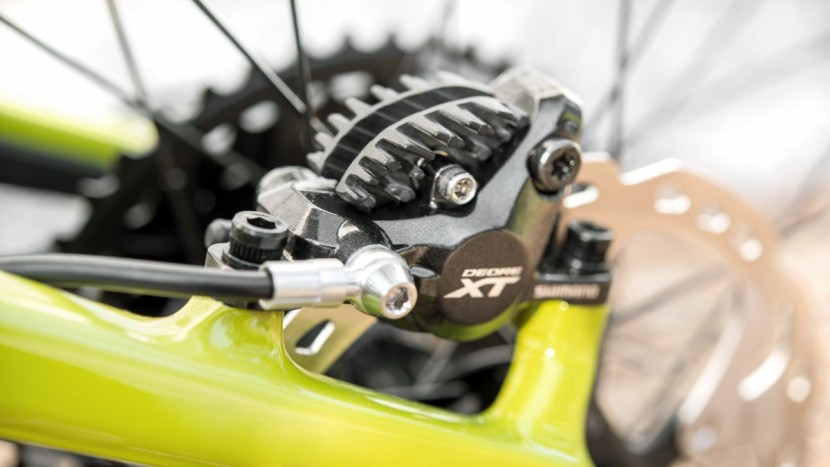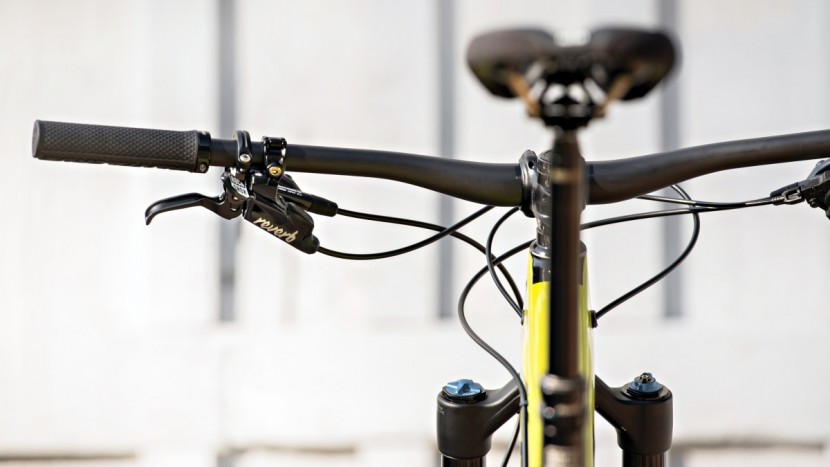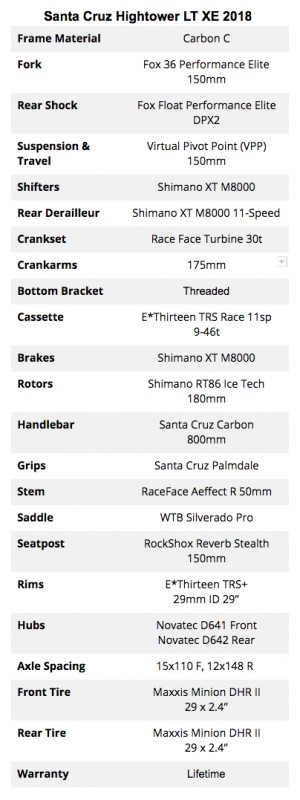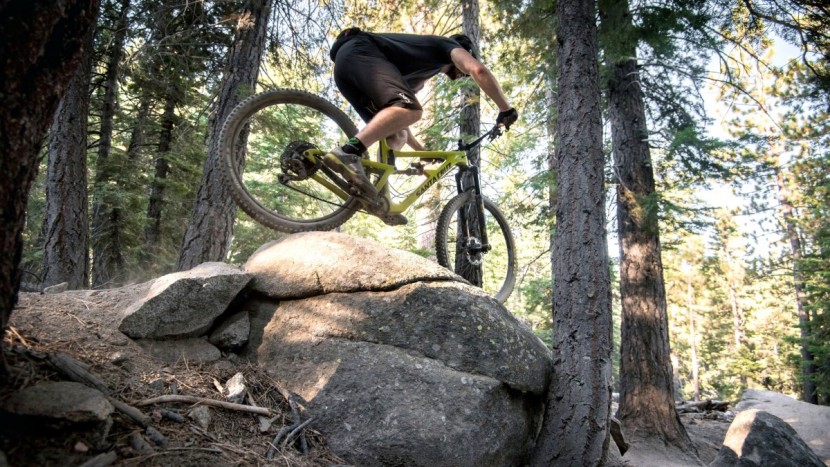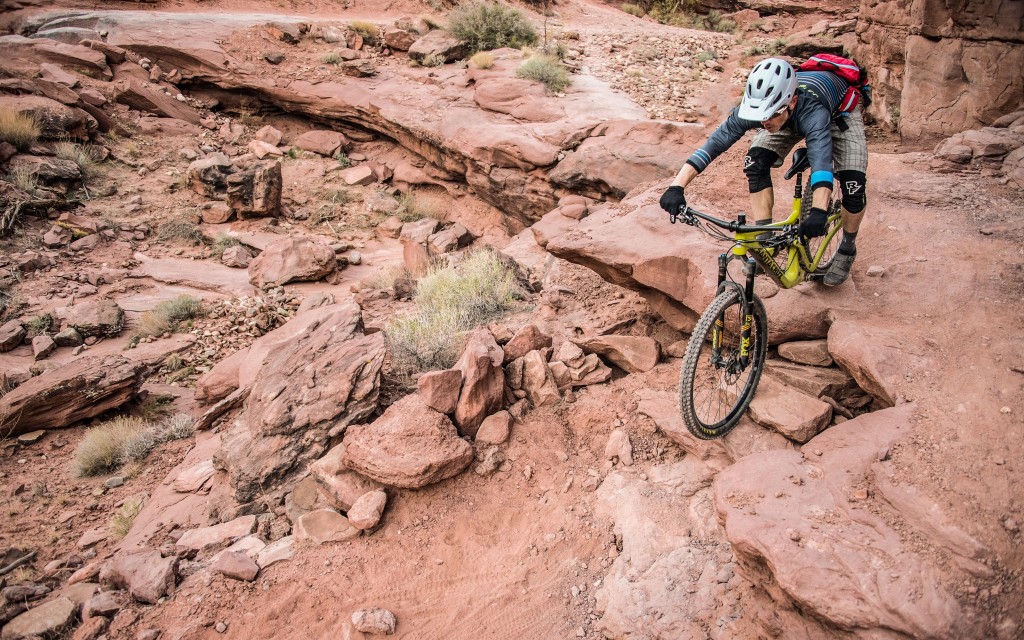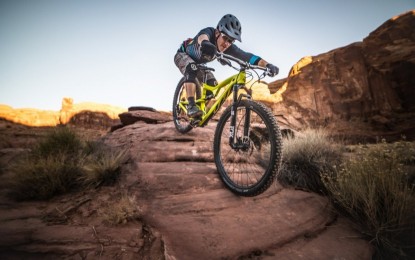Santa Cruz Hightower LT XE 2018 Review
Our Verdict
Our Analysis and Test Results
Two OutdoorGearLab testers piloted this aggressive 29er across a wide range of terrain and soil types in California, Nevada, and Oregon. They also raced it head-to-head against the Yeti SB5.5 and rated it against every trail mountain bike we've ridden. They found the 2018 Hightower LT to be a long-travel 29er with an aggressive downhill attitude that maintains spectacular climbing manners. This big-wheeler is happy to tear down flow trails and then climb two hours to attack some enduro-grade rocky descents.
Fun Factor
The Hightower LT is a fun bike due to the enormous range of terrain it can ride. There is no doubt this bike lacks the zippy and playful attitude of many shorter travel rigs. That said, relatively sharp handling makes for a lively ride.
Having plenty of options is fun. With the Hightower LT, you can blast out a 40-mile epic trail ride one day and then go shred park laps the next day. Enduro race or backcountry exploration ride, the choice is yours. While having a versatile bike may not necessarily be fun in the smiling and giggling sense, it is no doubt important. With the LT, the world is your oyster.
The Hightower LT prefers to live its life on the ground building speed. This bike is more than comfortable on a jump line or railing berms, but it much prefers to go fast. Really fast. As a wise man once said, going fast is fun. Handling is reasonably sharp and lively and the bike operates better the faster it is ridden.
The Yeti SB5.5 has the same appetite for velocity as the LT. The Hightower LT has slightly more playful trail manners compared to the Yeti. The SB5.5's bulky front end feels a bit more grounded than the Santa Cruz. Given the relative bulk of both of these bikes neither encourage a particularly high amount of jumping around. The Yeti 5.5 has a more pleasant climbing motion than the Hightower LT. Less pain uphill = more fun. The 135mm Santa Cruz Hightower Jr offers a more playful feel. This is especially the case at slower speeds.
The Hightower LT and the Yeti SB130 both turn up near the top of the list their fun factor. What is more fun than being able to charge an enormous range of terrain? The Ibis Ripley is another top scorer for its amazing, rally-car, handling, and fun-loving attitude.
Downhill Performance
The Hightower LT produces impressive red-lining 29er performance that handles chop in a composed manner. The 150mm of rear wheel travel fits the geometry of this frame seamlessly and handles the overwhelming majority of trail with ease. High-speed flow sections are a blast and the LT handles well through berms. Minimal body language is required to get this bike to obey instructions. But when the gnar factor is cranked to 11 and things get real steep, this bike could benefit from a slacker geometry.
Impressive descending skills are only helped by the plush yet progressive Fox suspension. The Fox 36 Performance Elite is stiff and features three compression settings including an open mode adjust. Two volume spacers came stock in this fork allowed us to run a lower fork pressure for a soft feel off the top with a significant ramp up midway through the stroke. The Float DPX2 rear shock is beautifully forgettable and reliable.
The angles on the Hightower LT are dialed for the overwhelming majority of downhill situations. Coming into rock gardens, the bike exudes confidence that you are going to lay waste to whatever lays in its path. The big wheels keep your front end out of trouble and preserved your speed on the exits. On extra-nasty, double black diamond, rock gardens, this bike requires more finesse. The Hightower LT handles it well, but it forces riders to pay extra attention to line choice. In this specific situation, the LT's 66-degree head tube angle feels steep. The 65-degree or 65.5-degree head angles found on some ultra-aggressive 29ers would be handy. That said, during a week of testing at a downhill park and on the burliest black diamonds we could find, we only encountered a handful of situations where the bike is spooked.
Shredding down a flowy ribbon of singletrack is simply sensational. Ripping this fluorescent bicycle out of corners is a pleasure. Hammering the pedals to keep building speed is effective thanks to the superb pedal platform. The Hightower boosts jumps and rolls well enough but prefers to live its life on the ground with massive speed. This is not the kind of 29er that we would label as especially playful 29er.
Handling abilities are respectable aboard this bike. Minimal body language is needed to yank the bars up to bounce over obstacles. The 800mm bars bring excellent stability at speed but can make for some awkward maneuvers when things get tight. Chunky, 2.4-inch Maxxis Minion DHR II tires offer superb grip when leaning into corners. A 2.5-inch Minion DHF up front would be even better. Another small, yet important, note is that we would have liked to see a chain guide included on the build spec. We dropped our chain a few times on extra rough terrain.
The Yeti SB5.5 is a comparable bike with a slightly more straight-lining approach. When we raced the LT and SB5.5 in our downhill time trials, they nearly tied. The Yeti feels better on rapid fire small bumps where the LT's anti-squat properties harshen the ride. The Yeti's 140mm of travel feels more harsh on the bigger impacts where the Santa Cruz just soaks it up. Handling is comparable between the two aggressive sleds. Mashing the pedals on the downhill to keep building speed is more efficient on the Santa Cruz, but good 'ol 29er rock plowing seems to be more effective on the Yeti. Downhill performance is a bit of a tossup between these two aggressive bikes. Riders who frequent burlier trails will like the way the Hightower stands up to the impacts. Folks who ride trails with fewer big hits might prefer the small bump compliance on the Yeti 5.5. Riders who prefer smoother or flowier trails without enormous amounts of chunk should look to the Santa Cruz Hightower (non-LT). This is a very capable 135mm trail bike, but it does have a limit on rowdy trails.
The Hightower LT and the Yeti SB5.5 were runaway winners in the downhill category. Both of these aggressive rigs top downhill test scores. The Santa Cruz Hightower, Rocky Mountain Altitude are a couple steps below.
Climbing Performance
The Hightower LT is a comfortable and efficient climber that feels more like a trail bike than an enduro bike on the ascent. A quick glance at the geometry sheet for the Hightower LT suggests that this bike was designed with climbing in mind. The 150mm of travel and a 66 head tube angle seem to target more a middle-of-the-road approach when compared to the raced-out Trek Slash or Norco Range.
When spinning uphill, power is transmitted effectively. The Hightower LT's 30 lbs 2 oz doesn't exactly make it a featherweight. That said, it doesn't feel bulky in the least. The 30-tooth chainring paired with the E*Thirteen 9-46 cassette provides a nice gear range. It takes a serious grade to overwhelm this gear ratio. When it is time to stand up and punch the LT, the VPP suspension remains firm and doesn't bounce or bob. We didn't find it necessary to firm up the compression settings on the Fox Float DPX2 save for gravel or fire roads.
Uphill handling is about what you would expect from a 150mm travel bike. Given the big wheels, and semi-slack geometry, you wouldn't call this bike especially surgical and precise. That said, navigating uphill switchbacks and rock gardens is fairly easy. Aside from the inherent bulk of 29-inch wheels, it is an easy task to gas this bike up and over uphill obstacles Even though handling is respectable, the ultra wide 800mm bars don't do you any favors, especially in tight areas. The 2.4-inch Maxxis Minion DHR II tires front and rear offer excellent climbing grip in all conditions.
Seated pedaling position is comfortable aboard the LT. The measured 71.1-degree effective seat tube angle is no-doubt slack. This didn't yield any noticeable inefficiencies but was visibly apparent when looking down towards the bottom bracket while pedaling.
The 631mm effective top tube and 450mm reach produce plenty of real estate to shuffle weight when the terrain calls for it. The climbing abilities more closely resemble those of a mid-travel trail bike compared to an enduro sled. Some burly bikes strain you mentally when climbing. The Commencal Meta AM 4.2 for instance, requires a calm and relaxed climbing position or it will grind your soul. The Hightower LT gives off an energized and fast feeling regardless of whether standing or seated.
The similar geometry on the Yeti SB5.5 results in a far different climbing experience. Rider position is further back on the Yeti where the climbing position is more forward and aggressive on the Santa Cruz. The 5.5's suspension is softer off of the top and results in better traction when climbing. In addition, the suspension movement moves in a manner that seems to propel the bike forward where the Hightower LT seems to get hung up. The suspension on the Hightower LT is noticeably calmer but gets stalled out on certain rocks. As a result, the SB5.5 finished our technical climbing time trails a bit ahead of the LT. The regular, 135mm Hightower (non-LT) is a smooth climber and provides more efficiency thanks to its steeper angles and shorter travel.
The Hightower LT takes a respectable place in the climbing category. While this isn't particularly highly ranked, it is impressive given its downhill focus. The Yeti SB5.5 ties. The short travel Pivot Mach 429, Santa Cruz Tallboy, Ibis Ripley, and Yeti SB130 all end up a the top of the list.
Ease of Maintenance
Mountain bikes are complicated machines. Some designs are inherently more difficult to work with while others are simple. It is important to consider this before pulling the trigger on a coveted new bike. Frame and linkage bearings will need to be serviced regularly. It is a good idea to find a local shop familiar with your brand of bike. Brakes, suspension, drivetrain, and dropper posts also need maintenance. We've ranked the Hightower LT below, read about our methods in the full trail bike review.
Santa Cruz' suspension design is relatively straightforward. The only quirk is that the pivot axles require a light torque value. The bearings that come stocks also wear out relatively quickly. Fox's prescribed suspension service intervals are longer than RockShox. As a result, we rate Fox forks and shocks as easier to maintain. Many mechanics state that they see Fox components come into the shop more often than RockShox, however. Be sure to take your bike in for a checkup whenever performance is suffering for an unknown reason. Shimano brakes are easier to work with than their SRAM alternatives and use mineral oil instead of SRAM's corrosive compounds.
Frame Design and Measurements
The Santa Cruz Hightower LT is a beefed up version of the original 135mm Hightower. The LT stands for long travel and this new iteration runs 29-inch wheels only and is built around 150mm of rear wheel travel. This charger utilizes Santa Cruz's Virtual Pivot Point (VPP) suspension design. VPP suspension uses two counter-rotating short links that create an “S” shaped wheel path. The suspension is quite progressive, offering support on big hits but sacrifices a bit of small bump compliance in the name of higher levels of anti-squat. Metal fans are out of luck, the LT is available in carbon fiber only.
Santa Cruz refrained from going too extreme or slack with the Hightower LT. We measured the head tube angle on our large test bike at 66.0-degrees. This head angle pairs with a 631mm effective top tube and 444 mm chainstays to produce a 1197mm wheelbase. This frame is designed with a measured 71.1-degree effective seat tube angle. The large Hightower LT weighs in at 30 lbs 2 oz without pedals or tubes.
Build
The Hightower LT has impressive ride characteristics and the on-trail performance was dialed. The build specifications complement the intended application well. That said, there are couple highlights and lowlights.
Fork and Shock — The XE build features a Fox 36 Performance Elite Fork with 150mm of travel. Our fork came stock with two volume spacers and did an excellent job balancing soft feel off the top and deep stroke support. This fork features a three position low-speed compression adjustment. We left it wide open through testing.
The Fox Float DPX2 shock was an appropriate specification. This shock stood up to bigger hits and it was fairly easy to dial in the rebound and compression settings. It went delightfully unnoticed throughout testing.
Wheels and Tires — E*Thirteen TRS+ rims with a 28mm inner diameter are laced to Novatec hubs. The rims provide a solid footprint for our 2.4-inch tires and were reasonably stiff. The Novatec D642 rear hub failed and was replaced with a DT Swiss 350 under warranty.
Maxxis Minion DHR 2.4-inch tires are mounted front and rear on our test bike. This is a dialed combination is a proven winner and provided excellent grip and braking bite.
Groupset — The XE build is powered by a Shimano XT 1x11 paired with an E*Thirteen TRS Race 46-tooth cassette. This provides a nice and comfortable 30:46 climbing gear. While the Shimano XT derailleur shifted crisply, the lever has a serious sticky feel. The E*Thirteen cassette is fantastic but wore more quickly than we would have liked.
Shimano XT brakes provide excellent stopping power and that on/off feel that riders either love or hate. The zone of modulation in the lever is much smaller in Shimano brakes compared to SRAM.
Handlebars, Seat, and Seatpost — Santa Cruz 800x35mm carbon bars are mounted to a 50mm stem. This is a stiff and stout combination that makes for a responsive front end. We feel 800mm is a little overkill in terms of width. We prefer 780mm bars.
The 150mm RockShox Reverb Stealth works well. This post features the new-style remote which is user-friendly. One complaint is there is no longer a return speed adjust at the remote.
Build Options
Our $5,699 XE build kit is far from cheap, and unfortunately, it is no longer offered. We would point you to the Hightower LT Carbon S version which is nearly identical to the model we tested with notable changes to the wheelset and the SRAM GX Eagle drivetrain.
The R kit is the entry level build and sells for $3,949. This version features a RockShox Revelation RC fork, Fox Float Performance DPS shock, SRAM NX drivetrain and Level T brakes. This build gets you on the dialed frame so long as you're okay with upgrading components over time. We feel this bike really needs a more aggressive rear shock like the Fox Float DPX2 on our test bike.
The S build sells for $4,899 and features a Fox 36 Performance fork with the GRIP damper, Fox Float Performance DPS shock and SRAM Guide R. The standout specification is the SRAM GX Eagle 12 speed drivetrain. This is a solid build for the rider who may not demand as much from their suspension but values a nice drivetrain.
The X01 build kit is a step up from our test bike and carries a lofty $6,799 price tag. This top-notch build kit features a Fox 36 Performance Elite 150mm fork, Float Performance Elite DPX shock, SRAM X01 Eagle 12 speed drivetrain, and SRAM Guide RSC brakes. There is no-doubt this build is dialed. There is also no doubt that this build is expensive.
Value
There is no doubt that the Hightower LT XE performs very well. The dialed, balanced performance and high fun factor are undeniable. The $5,699 price tag is definitely on the hefty side. That said, Fox Performance Elite suspension, Shimano XT brakes, and XT 1x11 drivetrain are reasonable build specifications when paired with such high performance. Check out the Carbon S build for a better deal and a price of $4,899.
Suggested Upgrades
The Hightower LT XE is ready to rip from day one. There are a couple suggested upgrades worth mentioning.
Noticeably absent on this build kit is a chain guide. For a bike designed for aggressive riding, this should be a must-have even with the advancements in clutch derailleurs. OneUp Components and E*Thirteen have some great options starting around $50.
If you have some cash laying around and want to be proactive, we recommend thinking about a wheel upgrade. The E*Thirteen rims are solid but we have a track record with failed Novatec hubs. A Stans Flow MK3 wheelset would be far more reliable and are a good value around $650.
Conclusion
The enduro category is constantly evolving. Many enduro race rigs feature too much travel and wildly slack geometry to serve as a true all-mountain bike. Santa Cruz takes a very well-rounded approach with the new Hightower LT. This balanced 150mm travel big rig offers excellent climbing abilities and crushing descending skills. This bike can truly do it all with an aggressive attitude. Trail-crushing daily driver or a ripping enduro race-rig, the Santa Cruz Hightower LT has you covered.


